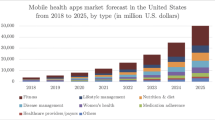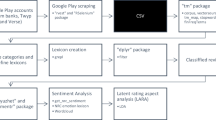Abstract
Internet as we know it, has entered a spiral of decline while mobile Apps are gradually taking over and are steadily changing the way we go about our individual daily lives. This study examines the fact that certain financial services Apps are far more successful than others, specifically by looking at what makes a user think that an App may be great, and give it a favorable review, or that it is rather ghastly, and give it an unfavorable review. Next, we describe a study of six of the most popular financial services Apps on the iTunes App Store, for which reviews were analyzed using DICTION software. Employing Diction variables, ambivalence and temporal terms were prevalent in negative reviews while accomplishment, motion, optimism and certainty, were predominantly expressed in positive reviews. Human interest, on the other hand, seemed to be uniformly distributed between both types of reviews.
Similar content being viewed by others
References
Avouris, N.M., and N. Yiannoutsou. 2012. A review of mobile location-based games for learning across physical and virtual spaces. Journal of Universal Computer Science 18 (15): 2120–2142.
Azar, K.M., L.I. Lesser, B.Y. Laing, J. Stephens, M.S. Aurora, L.E. Burke, and L.P. Palaniappan. 2013. Mobile applications for weight management: Theory-based content analysis. American Journal of Preventive Medicine 45 (5): 583–589.
Baptista, G., and T. Oliveira. 2016. A weight and a meta-analysis on mobile banking acceptance research. Computers in Human Behavior 63: 480–489.
Bredican, J., and D. Vigar-Ellis. 2014. Smartphone applications-idea sourcing and app development: Implications for firms. South African Journal of Economic and Management Sciences 17 (3): 232–248.
Chen, C. 2013. Perceived risk, usage frequency of mobile banking services. Managing Service Quality 23 (5): 410–436.
Does Uganda Have More Mobile Phones Than Light Bulbs? 2016. Retrieved from http://afkinsider.com/122194/does-uganda-have-more-mobile-phones-than-light-bulbs/#sthash.BTvGnUEf.dpuf.
Fisher, R.J., and J.E. Katz. 2000. Social desirability bias and the validity of self-reported values. Psychology and Marketing 17 (2): 105–120.
Fu, B., J. Lin, L. Li, C. Faloutsos, J. Hong, and N. Sadeh 2013. Why people hate your app: Making sense of user feedback in a mobile app store. In Proceedings of the 19th ACM SIGKDD international conference on knowledge discovery and data mining, 1276–1284. ACM.
Gu, J.C., S.C. Lee, and Y.H. Suh. 2009. Determinants of behavioral intention to mobile banking. Expert Systems with Applications 36 (9): 11605–11616.
Hanafizadeh, P., B.W. Keating, and H.R. Khedmatgozar. 2014. A systematic view of internet banking adoption. Telematics and Informatics 31 (3): 492–510.
Harman, M., Y. Jia, and Z. Test 2012. App store mining and analysis: Msr for app stores. In Proceedings of the 9th working conference on mining software repositories (MSR ’12), Zurich, Switzerland, 2–3 June 2012.
Harris, J., B. Ives, and I. Junglas. 2012. It consumerization: When gadgets turn into enterprise IT tools. MIS Quarterly Executive 11 (3): 99–112.
Harris, Mark A., S. Furnell, and K. Patten. 2014. Comparing the mobile device security behavior of college students and information technology professionals. Journal of Information Privacy and Security 10: 186–202.
Harris, M.A., A.G. Chin, and R. Brookshire. 2015. Mobile app installation: The role of precautions and desensitization. Journal of International Technology and Information Management 24 (4): 3.
Huguet, A., S. Rao, P.J. McGrath, L. Wozney, M. Wheaton, J. Conrod, and S. Rozario. 2016. A systematic review of cognitive behavioral therapy and behavioral activation apps for depression. PLoS ONE 11 (5): 1–19.
Iker, H.P. 1974. SELECT: A computer program to identify associationally rich words for content analysis. Computers and the Humanities 8 (5): 313–319.
Johnson, M., and M. Verdegaal. 2016. How traditional banks are innovating the basics to provide customers with an Uber-like mobile banking experience. Journal of Digital Banking 1 (1): 33–44.
Jones, B., and A.G. Chin. 2016. On the efficacy of smartphone security: A critical analysis of modifications in business students’ practices over time. International Journal of Information Management 35 (5): 561–571.
Kim, W.H., L. Lee, and J.E. Son. 2011. An exploratory study on the determinants of smartphone app purchase. In The 11th international DSI and the 16th APDSI joint meeting, Taipei, Taiwan, July 2011.
Lella, A., A. Lipsman, and B. Martin. 2015. The 2015 U.S. mobile app report. Retrieved from https://www.comscore.com/Insights/Presentations-and-Whitepapers/2015/The-2015-US-Mobile-App-Report.
Maslow, A.H. 1943. A theory of human motivation. Psychological Review 50 (4): 370.
Morgan, J. 2015. The power of the App: Can mobile-technology save lives? Lancet Neurology 15: 668.
Morrison, S., L. Pitt, and J. Kietzmann. 2015. Technology and financial services: Marketing in times of U-commerce. Journal of Financial Services Marketing 20 (4): 273–281.
Mudambi, S.M., and D. Schuff. 2010. What makes a helpful online review? A study of customer reviews on amazon.com. MIS Quarterly 34 (1): 185–200.
Parker W. 2015. LG jumps on the mobile payments bandwagon. Retrieved from http://www.techradar.com/news/phone-and-communications/mobile-phones/lg-making-its-own-version-of-mobile-payments-1309316.
Pitt, L.F., M. Parent, I. Junglas, A. Chan, and S. Spyropoulou. 2011. Integrating the smartphone into a sound environmental information systems strategy: Principles, practices and a research agenda. The Journal of Strategic Information Systems 20 (1): 27–37.
Quiroz, P.A. 2013. From Finding the perfect love online to satellite dating and’ loving-the-one-you’re near’: A look at Grindr, Skout, Plenty of Fish, Meet Moi, Zoosk and Assisted Serendipity. Humanity and Society 37 (2): 181.
Schmitz, B., R. Klemke, and M. Specht. 2012. Effects of mobile gaming patterns on learning outcomes: A literature review. International Journal of Technology Enhanced Learning 4 (5): 345–358.
Shen, G. 2015. Users’ adoption of mobile applications: Product type and message framing’s moderating effect. Journal of Business Research 68: 2317–2321.
Shen, N., M.J. Levitan, A. Johnson, J.L. Bender, M. Hamilton-Page, A.A.R. Jadad, and D. Wiljer. 2015. Finding a depression app: A review and content analysis of the depression app marketplace. JMIR mHealth and uHealth 3 (1): e16.
Shi, Y. 2011. iPhones in China: The contradictory stories of media-ICT globalization in the era of media convergence and corporate synergy. Journal of Communication Inquiry 35 (2): 134–156.
Statista (n.d.). Number of mobile phone users worldwide from 2013 to 2019 (in billions). Retrieved from http://www.statista.com/statistics/274774/forecast-of-mobile-phone-users-worldwide/.
Statista (n.d.). Number of mobile app downloads worldwide from 2009 to 2017 (in millions). Retrieved from http://www.statista.com/statistics/266488/forecast-of-mobile-app-downloads/.
Strawson, P.F. 1950. On referring. Mind, New Series 59 (235): 320–344.
Stibel, J. 2013. The web is dead-and the app (thankfully) killed it. Retrieved from http://www.wired.co.uk/article/the-web-is-dead-and-the-app-thankfully-killed-it.
Veríssimo, J.M.C. 2016. Enablers and restrictors of mobile banking app use: A fuzzy set qualitative comparative analysis (fsQCA). Journal of Business Research 69 (11): 5456–5460.
Wijland, R., P. Hansen, and F. Gardezi. 2016. Mobile nudging: Youth engagement with banking apps. Journal of Financial Services Marketing 21 (1): 51–63.
Zydney, J.M., and Z. Warner. 2016. Mobile apps for science learning: Review of research. Computers and Education 94: 1–17.
Author information
Authors and Affiliations
Corresponding author
Rights and permissions
About this article
Cite this article
Vella, J., Wallström, Å. & Farshid, M. Financial services Apps: What makes the difference between a great and a ghastly review?. J Financ Serv Mark 22, 132–138 (2017). https://doi.org/10.1057/s41264-017-0031-8
Revised:
Published:
Issue Date:
DOI: https://doi.org/10.1057/s41264-017-0031-8




